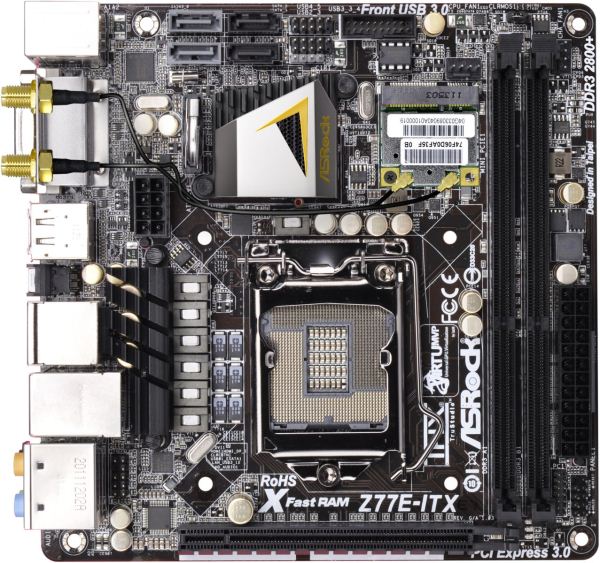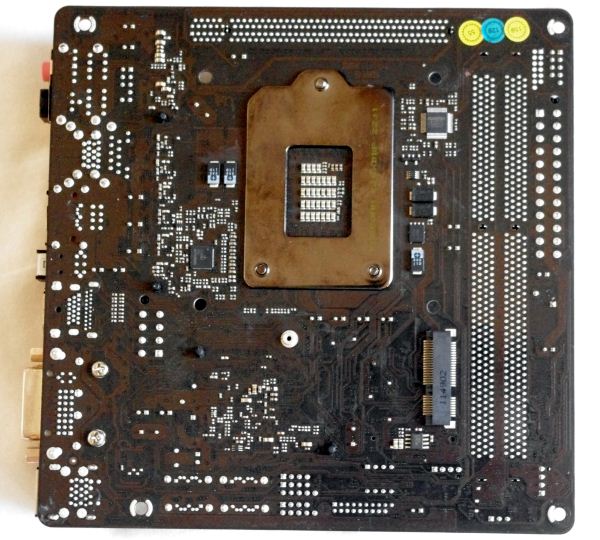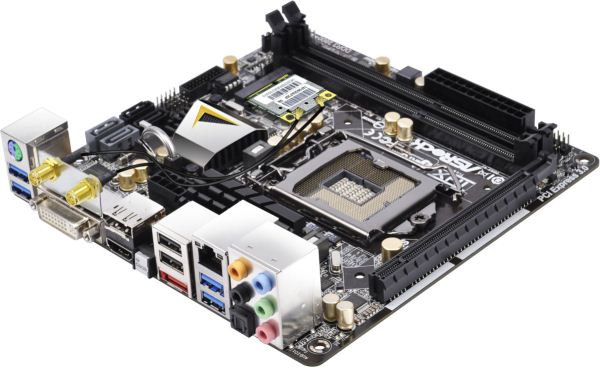Z77 mITX Round-Up: Five of the Best – MSI, Zotac, ASRock, EVGA and ASUS
by Ian Cutress on December 31, 2012 7:00 AM EST- Posted in
- Motherboards
- MSI
- ASRock
- EVGA
- ZOTAC
- Asus
- Ivy Bridge
- Z77
- mITX
ASRock Z77E-ITX Overview
Before I even started testing the ASRock Z77E-ITX, I could see murmurings online in the various forums I use about it. For the interests of remaining unbiased, I steered away from those threads. The ideal scientific test of a motherboard would be a double-blind study – the board can be reviewed and tested, but any tell-tale signs or markings on the product pointing it towards a single manufacturer would be removed. Unfortunately testing is not always scientifically perfect, but we can at least be as thorough as possible in our analysis.
The ASRock Z77E-ITX presents the user with a novel way (in the consumer desktop space) of solving the issue of limited PCB area – moving components to the rear of the motherboard. We are not talking just resistors – ASRock have moved the mSATA port to the rear. This frees up the main topside of the PCB for a mini-PCIe with 802.11b/g/n WiFi, a proper location for the 8-pin CPU connector, an easier-to-remove BIOS chip, and a lot more components on the board. This thing looks filled.
Other functionality on board gives us a Broadcom BCM57781 network controller, the Realtek ALC898 audio codec and an ASMedia ASM1042 USB 3.0 controller. The two 4-pin fan headers are found on the top left of the board, although on closer inspection the power delivery chokes may give cause for concern. Their open top design suggests iron core chokes, similar to those used on low end motherboards, rather than the iron powder or alloyed chokes on their higher end models. However after talking to ASRock, these are actually iron ferrite chokes, used for small space / high power systems such as servers. This should lead to reasonable temperatures under severe stress, and typically server parts are rated to be more than adequate for that severe stress.
The BIOS of the Z77E-ITX uses the older UEFI design of white on blue, compared to the new starry background design and distribution of options. We still get access to the System Browser, which cunningly gives a peak of the back of the board due to that mSATA placement, the Online Management Guard and Internet Flash for BIOS updates through the internet. We also get the dehumidifier functionality for equilibrating high-moisture situations inside and outside the case to reduce condensation in those climates. Software is standard ASRock, with ASRock always wanting to promote their XFast 555 system of RAM, LAN and USB. The latter may not be of use under Windows 8, and the chances of RAM cache use in a mITX are slim, but access over the network priority is a useful tool to have. While the fan controls are not the best, they did work in my testing over the range of tools available.
The ASRock Z77E-ITX sits at the low end in terms of cost in our review at $150 – significantly cheaper than the EVGA at least. With a weird orthogonal antenna in the box, DVI-I to D-Sub adaptor too, and performance which is not too far off from what we expect from the platform, the ASRock does pull at the wallet waiting for a build.
Visual Inspection
Like most motherboard manufacturers at the minute, ASRock has their color scheme – in this case we the aim is for a gold and black combination, however the way ASRock designs its motherboards means that we also get a lot of white. This is due to the placement of the components via SMT – in order to guide the automated process which places the components on board, each component has a small white box around where it should be. All these boxes printed on the board means that technically ASRock has less space to place components, and it alters the aesthetic perception of the product in the end.
Starting with the socket placement, ASRock like others in this review have placed the socket underneath the chipset and up against the memory/PCIe slots. This restricts coolers to the x-y dimensions specified by Intel, unless one invests in low profile memory. As always with mITX gaming builds, I would recommend an all-in-one liquid cooler. The socket area has access to both of the CPU fan headers on board – the 4-pin CPU header is above the mini-PCIe slot, and the 4-pin chassis header is to the top right of the memory slots. Arguably placing the two fan headers close together may not be the best idea in terms of placement.
The rear of the board is where we find this mSATA port. Now that mSATA drives are below the $1/GB, they become a wonderfully viable option in the motherboard space for those wanting to save space or who are not going RAID-0. (Even though there could be scope for two mSATA on motherboards in the future.)
North of the socket we have the chipset heatsink, which ASRock have decided not to connect to the power delivery heatsink. As mentioned previously, the style of the chokes used in the power delivery seems to suggest that simple iron cores are being used. Simple iron cores are the current low end and cheaper implementation of chokes, leading to lower efficiency and high heat loss, especially when compared to iron powder chokes, alloy chokes, super ferrite chokes, or PowIRstages. Talking with ASRock points these chokes towards the iron ferrite versions used in servers, meaning that they should still be able to provide enough power during overclocks, even if the mITX motherboard is not the ideal place to start overclocking a motherboard to the fullest – especially given that Ivy Bridge processors can get very hot in correlation to their voltage.
Around the chipset heatsink we get the SATA ports – two SATA 6 Gbps and two SATA 3 Gbps. The motherboard battery is stood straight out of the motherboard in order to save space, and below this we have the 8-pin ATX power connector. This is still in the middle of the board but perhaps not as bad as other implementations which require the power cables to stretch over everything in order to get to it. To the right of the chipset we have a USB 3.0 header, as well as the mini-PCIe port with a 2.4 GHz 802.11b/g/n WiFi module already strapped to it.

The rear IO panel looks more like a standard ATX build rather than a mITX oriented one. From left to right we have a combination PS/2, two USB 3.0 from an ASMedia ASM1042, the two antenna ports, a DVI-I, HDMI, DisplayPort, a Clear_CMOS button, two USB 2.0, an eSATA, a Broadcom BCM57781 network port, two USB 3.0 from the chipset and audio jacks containing an optical SPDIF output.
Board Features
| ASRock Z77E-ITX | |
| Price | Link |
| Size | Mini ITX |
| CPU Interface | LGA-1155 |
| Chipset | Intel Z77 |
| Memory Slots |
Two DDR3 DIMM slots supporting up to 16 GB Up to Dual Channel, 1066-2800 MHz |
| Video Outputs |
HDMI DisplayPort DVI-I |
| Onboard LAN |
Broadcom BCM57781 802.11 b/g/n WiFi |
| Onboard Audio | Realtek ALC898 |
| Expansion Slots |
1 x PCIe 3.0 x16 1 x mSATA 1 x mPCIe |
| Onboard SATA/RAID |
2 x SATA 6 Gbps (Chipset) RAID 0, 1, 5, 10 2 x SATA 3 Gbps (Chipset) RAID 0, 1, 5, 10 1 x mSATA 3 Gbps (Chipset) 1 x eSATA 3 Gbps (Chipset) |
| USB |
4 x USB 3.0 (Chipset) [2 back panel, 2 onboard] 2 x USB 3.0 (ASMedia ASM1042) [2 back panel] 6 x USB 2.0 (Chipset) [2 back panel, 4 onboard] |
| Onboard |
2 x SATA 6 Gbps 2 x SATA 3 Gbps 1 x mPCIe (Used by WiFi b/g/n) 1 x mSATA 3 Gbps (on rear) 2 x USB 2.0 Headers 1 x USB 3.0 Header 2 x Fan Headers 1 x Front Panel Audio |
| Power Connectors |
1 x 24-pin ATX Power Connector 1 x 8-pin CPU Power Connector |
| Fan Headers |
1 x CPU (4-pin) 1 x CHA (4-pin) |
| IO Panel |
1 x Combination PS/2 Port 2 x Antenna 1 x DVI-I 1 x HDMI 1 x DisplayPort 1 x Clear_CMOS Button 2 x USB 2.0 1 x eSATA 3 Gbps 1 x Broadcom NIC 4 x USB 3.0 1 x Optical SPDIF Output Audio Jacks |
| Warranty Period | 3 Years |
| Product Page | Link |
Compared to the other boards in the review, the use of a Realtek ALC898 is good to see, whereas the Broadcom BCM57781 NIC is an unknown factor. I like the mSATA and mPCIe combination, and putting the mSATA on the rear of the board is a great idea – it means that in the future other items such as the battery or SATA ports may migrate there as well. Price wise the ASRock board comes in as one of the cheapest in this review, and given the inclusions in the package (shown later), it makes it a nice product all around from a technical standpoint. The only additions I would have liked to have seen onboard is a two-digit debug, and if possible, power/reset buttons.














54 Comments
View All Comments
mike_b - Monday, December 31, 2012 - link
Interesting article, but I have to ask why would someone spend more for a Z77 chipset when using 'just' an i3? Surely a much cheaper H61 chipset could do the job admirably, and at much lower cost.Z77 makes sense if you're overclocking, which is excluded from this test...
IanCutress - Monday, December 31, 2012 - link
H61 has no chipset USB 3.0, no chipset SATA 6 Gbps, and you are limited to PCIe 2.0. H61 is also technically limited to one single sided DIMM per channel, and no SATA RAID. There's also SRT to consider, that would be advantageous with the ASRock and the mSATA on the rear.Ian
mike_b - Monday, December 31, 2012 - link
It might make an interesting comparison to see what net advantage is gained with the added features of the Z77 chipset compared with the H61. If budgets are limited the ~100 dollar cost difference between the Z77 and H61 mainboards makes a big difference; that money saved could be put into something which makes more of a performance difference (SSD rather than HDD for example).Anandtech is one of the best tech sites around, you guys do a great job. I do sometimes see though an emphasis on more expensive products when in terms of real-world performance you could get almost the same thing at a much cheaper price. Might be worth mentioning somewhere.
Not least because with yet another new socket coming with Haswell all these 1155 boards will be seen as out of date soon anyway.
IanCutress - Monday, December 31, 2012 - link
Once we get into the swing with Haswell, we will hopefully covering the whole spectrum. Though it is worth noting that motherboard manufacturers, want to put their best foot forward, and would prefer their halo/channel boards get covered before their OEM / low end offerings. Hence this is why you rarely see many mainstream reviews that are not from forums dedicated to the market segment and users testing their own equipment. We are hoping to rectify the balance in due course. If there are any specific products you might want us to test or examine, drop me an email and I'll see what I can put in my schedule (as full as it is[!]) :)Ian
StormyParis - Monday, December 31, 2012 - link
This is a major issue, not limited to motherboards: whenever I'm looking for something middle of the road or outright cheap, I can't find reviews.These Z77 MBs are a nice example: even though I'm recommending/building PCs regularly, most of them mini-ITX, I never came across a use case for Z77. Nobody apart from teens that still have something to prove overclocks anymore. People who want to do multi-GPU get a big case, and a big board. Are we supposed the extrapolate that the makers of good Z77 boards also make good H77 and H61 boards ?
I understand you've got to make do with what you're given by the OEMs. And that reviews was very good, as usual. Pity it is irrelevant ?
Tech-Curious - Monday, December 31, 2012 - link
That's an interesting observation. I have to say, I never noticed a significant lack of coverage for low-to-mid-range components (either in general or on Anandtech in particular), until this Fall, when I was in the market for a lower end motherboard.I guess I just always gravitated to higher end mobos before. Or maybe the coverage for such products was more comprehensive years ago. My memory's foggy, so it's hard to say.
In any case, motherboards appear to be the exception. If anything, I think the internet has generally grown more bullish on low-to-mid-range CPUs and GPUs in recent years (probably, in part, as a result of the stagnating console situation, which results in stagnating system requirements for games).
But all of that rambling aside, yeah. It'd be nice to see more diverse motherboard analysis. When I bought a b75 a couple of months ago, I literally couldn't find a review for that chipset. It wasn't a big deal; it's not like b75's features are any great mystery, after all -- but it is a little nettlesome to trip over sixty bajillion z77 reviews when there's nary peep about any other chipset.
In other news, Ian's review is a good one -- and given that I've been a faithful user of Asus motherboards for the last 15 years, it's nice to see them take home the prize. :)
Etern205 - Saturday, January 5, 2013 - link
My guess would be, why review a cheap board when majority of the readers here won't even bother buying it?And as for Asus boards, I've heard, they do something called based-line features. This means all boards from the bottom of the range to the top (Intel B75-Z77) will have the same base-line features, other features are just added like BT, WiFi, extra lan, etc.
Tech-Curious - Wednesday, January 9, 2013 - link
Yes, I think the issue is that (at least with respect to Intel chipsets) low-end motherboards don't support overclocking. So they're both less interesting to review (fewer measurable differences in performance among different models), and they're less appealing to the presumed audience of sites like Anandtech.Still, the B75 is a perfectly good chipset. If you aren't heavily invested in overclocking, z77's advantages are likely wasted on you. Personally, I'm well beyond my overclocking days; I just don't have the time or the patience to go through the almost endless tuning process anymore. (Even if you find a stable OC at the outset, it can become unstable later, and/or a given application might expose instability that stress testing didn't, weeks or even months down the road).
jonjonjonj - Friday, January 4, 2013 - link
just cause you don't overclock doesn't mean other people don't. why wouldn't you? because you want to get the fastest cpu that you can afford means you have something to prove? some people are just idiots.Zap - Monday, December 31, 2012 - link
But there isn't a $100 difference between H61 and Z77. There is a cheaper Gigabyte Z77 ITX board that's only around $60 more than the cheapest H61 ITX board, and it was even on sale recently for another $13 off making it less than $50 difference.Alternately one can go the H77 ITX route and get all the Z77 goodies except for overclocking, for around $30 less than the cheapest Z77 ITX. I think $30 more than H61 is reasonable for those extra features, plus guaranteed out-of-the-box BIOS support for Ivy Bridge.
I do agree with your (mike_b) first post regarding the choice of CPU used. Ian Cutress, didn't you have a spare K CPU laying around? There are so many people building overclocked ITX rigs these days. I did in a Silverstone SG05 with low profile air cooler to hit 4.2GHz. Plenty of others use the Bitfenix Prodigy and liquid cooling to hit clocks normally reserved for ATX rigs. Another review site (Tweaktown) tested overclocking on Z77 ITX boards and the ASRock hit near 4.8GHz. THAT'S what I want to see.
Of course this AnandTech roundup has some very useful information too, such as DPC latency tests and POST times. Keep up the good work there! But please, know your audience. Next time if the board is supposed to be overclockable, test that feature.
Maybe there can be a companion article about overclocking and heatsink clearance? Would be a shame to not overclock this nice collection of Z77 ITX boards.